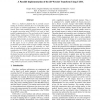Free Online Productivity Tools
i2Speak
i2Symbol
i2OCR
iTex2Img
iWeb2Print
iWeb2Shot
i2Type
iPdf2Split
iPdf2Merge
i2Bopomofo
i2Arabic
i2Style
i2Image
i2PDF
iLatex2Rtf
Sci2ools
PDP
2009
IEEE
2009
IEEE
A Parallel Implementation of the 2D Wavelet Transform Using CUDA
There is a multicore platform that is currently concentrating an enormous attention due to its tremendous potential in terms of sustained performance: the NVIDIA Tesla boards. These cards intended for general-purpose computing on graphic processing units (GPGPUs) are used as dataparallel computing devices. They are based on the Computed Unified Device Architecture (CUDA) which is common to the latest NVIDIA GPUs. The bottom line is a multicore platform which provides an enormous potential performance benefit driven by a non-traditional programming model. In this paper we try to provide some insight into the peculiarities of CUDA in order to target scientific computing by means of a specific example. In particular, we show that the parallelization of the two-dimensional fast wavelet transform for the NVIDIA Tesla C870 achieves a speedup of 20.8 for an image size of 8192x8192, when compared with the fastest host-only version implementation using OpenMP and including the data transfe...
| Added | 19 May 2010 |
| Updated | 19 May 2010 |
| Type | Conference |
| Year | 2009 |
| Where | PDP |
| Authors | Joaquín Franco, Gregorio Bernabé, Juan Fernández, Manuel E. Acacio |
Comments (0)

